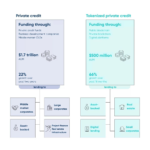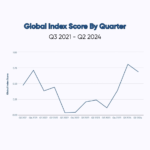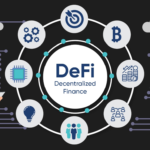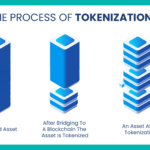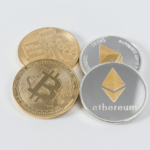Introduction
Imagine unique digital certificates proving ownership of online creations. That’s what Non-Fungible Tokens (NFTs) are – special blockchain tokens for digital assets. This white paper explores NFTs, their recent rise, and how they’re changing things. We’ll look at how artists, gamers, and even businesses are using them, along with the legal and technical aspects of NFTs, and see what the future holds.
Definition of NFTs
The digital world is full of copies, but what if you could own a unique digital item, like a one-of-a-kind piece of artwork or a rare in-game weapon? Enter Non-Fungible Tokens or NFTs. These aren’t your typical digital currencies. Unlike Bitcoin, where every unit is identical and interchangeable, NFTs are special certificates built on blockchain technology that cannot be replicated.
Blockchain acts like a secure public digital ledger, verifying the authenticity and tracking the ownership history of each NFT. This technology empowers both creators and collectors. Artists can finally prove they’re the original creators of their digital work, while collectors gain a verifiable record of ownership for their prized digital assets.
With NFTs, the concept of ownership takes a leap into the digital age, offering exciting possibilities for a wide range of creative fields and online interactions.
Brief History and Emergence
The concept of non-fungible tokens emerged in the early 2010s with the rise of colored coins on the Bitcoin blockchain. These were essentially attempts to imbue individual Bitcoin’s with unique properties, a concept that laid the groundwork for non-fungible tokens. However, the term "NFT" gained mainstream recognition in 2017 with the launch of CryptoKitties, a game where players could buy and sell virtual cats represented by NFTs.
Since then, the NFT market has experienced explosive growth, with sales reaching over $41 billion in 2021, and the NFT market revenue is expected to reach US$2,378.0m in 2024, demonstrating the immense potential of NFTs to revolutionize how we interact with digital assets.
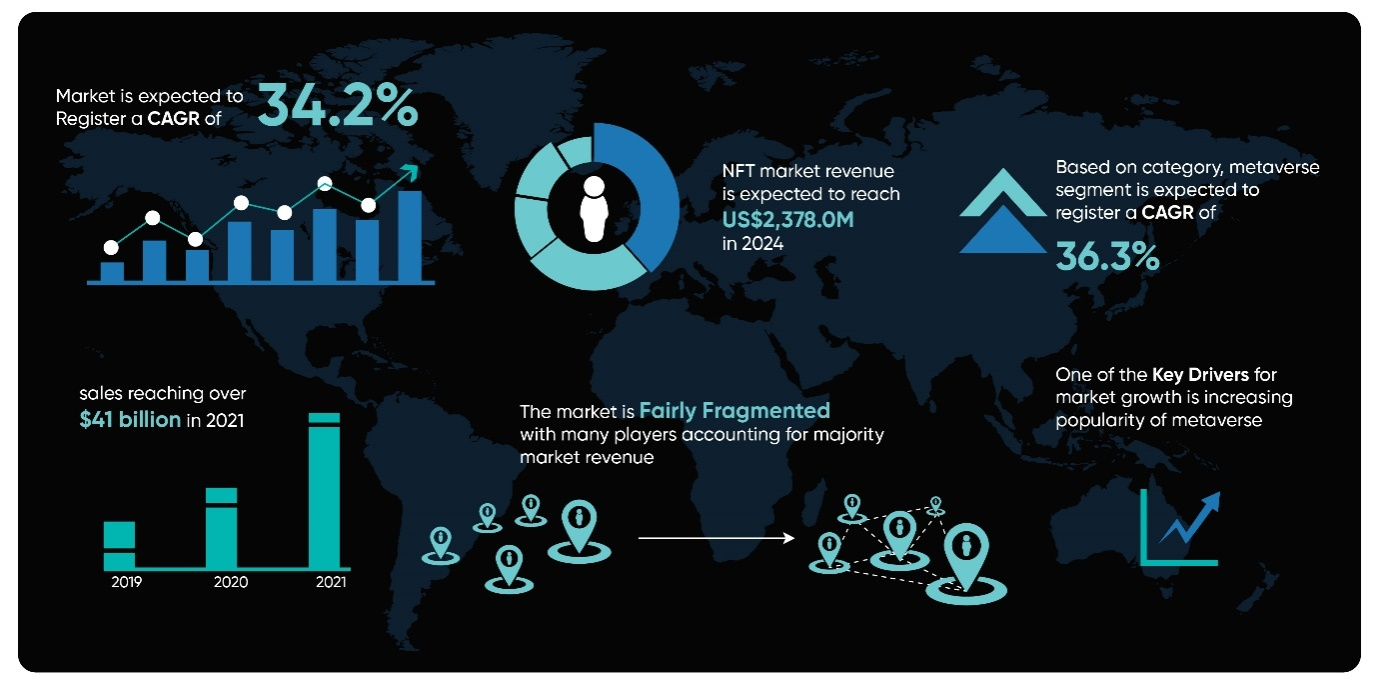
Significance and Impact on Various Industries
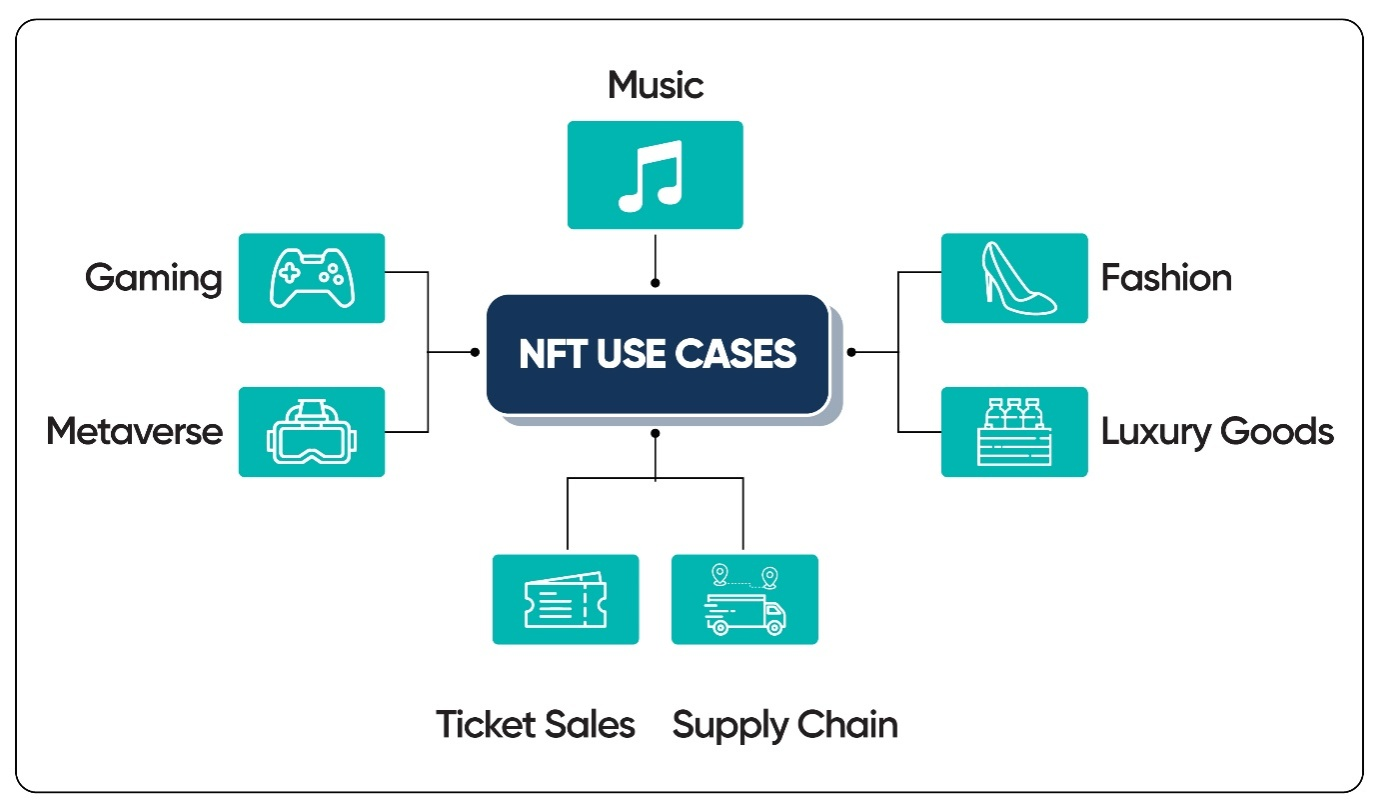
NFTs are revolutionizing how we interact with digital assets across various industries. In the art world, NFTs enable artists to sell and authenticate their digital creations, opening new avenues for monetization and fostering a vibrant digital art market. Within gaming, NFTs represent unique in-game items and characters, empowering players with true ownership and fostering play-to-earn models. Beyond art and gaming, NFTs have the potential to disrupt and transform sectors such as:
- Supply chain management
The potential of NFTs extends far beyond the creative and entertainment industries. In supply chain management, NFTs can track product provenance, ensuring authenticity and streamlining logistics. This can significantly combat counterfeiting and improve transparency throughout the supply chain.
- Ticketing and event management
NFTs can represent unique tickets for events, offering a secure and verifiable way to control access. This eliminates the risk of ticket forgery and scalping, ensuring a smoother and more secure experience for event organizers and attendees alike.
- Identity management
NFTs hold the potential to revolutionize identity management by creating secure and portable digital identities. These identities could be used across different platforms and applications, simplifying verification processes and enhancing online security.
- Intellectual property
NFTs can represent ownership of digital media like music, photography, avatar accessories, and literature. This offers creators new ways to manage licensing and royalties, ensuring they receive proper compensation for their intellectual property in the digital age. This can help address the challenges associated with copyright infringement and ensure fair treatment for creators across various media industries.
Understanding NFTs
Characteristics of NFTs
As previously mentioned, NFTs are unique digital identifiers stored on a blockchain. Unlike fungible tokens like cryptocurrency, each NFT is irreplaceable and possesses distinct properties. Here are some key characteristics of NFTs:
- Uniqueness: Each NFT is one-of-a-kind and cannot be replicated.
- Indestructible: Ownership of an NFT is recorded on a transparent and tamper-proof blockchain ledger.
- Ownership: NFTs can be bought, sold, or traded on dedicated marketplaces.
- Specific Programmability: Through smart contracts, NFTs can be programmed with specific functionalities, such as granting access to exclusive content or royalties to creators.
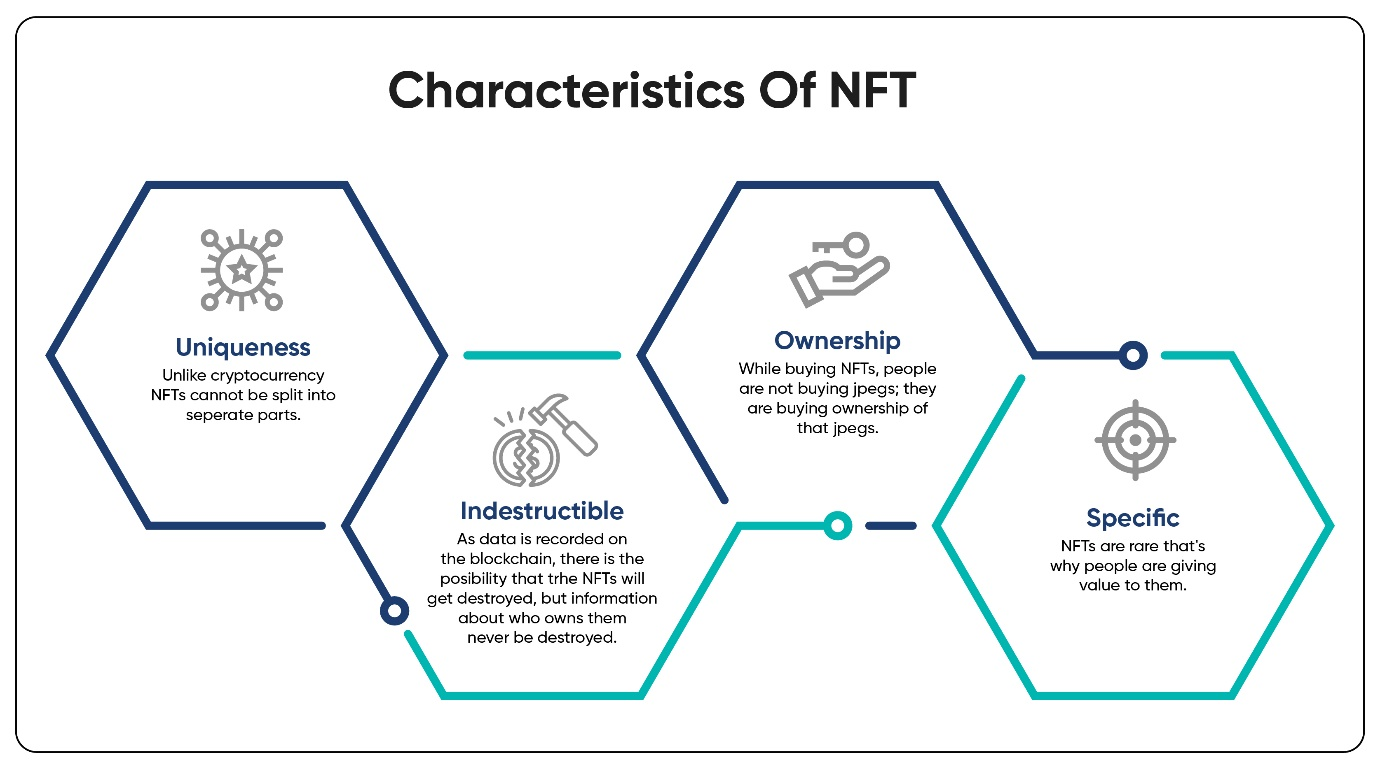
Comparison with Fungible Tokens and Physical Assets
It’s important to understand the distinction between NFTs and other types of digital assets. Unlike fungible tokens like Bitcoin or Ethereum, which are essentially interchangeable units with identical value, NFTs are one-of-a-kind. Think of fungible tokens like dollar bills – each one is worth the same, and you wouldn’t hesitate to trade one for another. NFTs, on the other hand, are more like unique collectibles, each with its own distinct properties and value.
This distinction is crucial. While NFTs can represent ownership of digital assets, they don’t necessarily translate to physical ownership of the underlying item. For instance, owning an NFT of a famous painting doesn’t mean you own the physical artwork hanging in a museum. However, the beauty of NFTs lies in their ability to tokenize physical assets. Imagine a rare piece of artwork or a historic property being represented by a secure NFT on a blockchain.
This NFT acts as a digital certificate of ownership, offering a transparent and verifiable way to track ownership history and ensure authenticity. This paves the way for secure and efficient trading of these assets on a digital platform, potentially revolutionizing sectors like real estate and art collecting.
Technical Aspects of NFTs
At the heart of every NFT lies the powerful technology of blockchain. Imagine a giant, public ledger distributed across a vast network of computers. This is essentially what a blockchain is – a secure and transparent way to record and track information. Each piece of information, like an NFT, is bundled into a block and chronologically chained together, creating an immutable record. This means that once data is added to a blockchain, it cannot be tampered with or deleted, fostering trust and transparency in the digital realm.
Here’s how blockchain technology underpins NFTs in more detail:
Minting
Minting refers to the process of creating a new NFT. When a digital asset, like a piece of artwork or a collectible item in a game, is converted into an NFT, it’s uploaded onto a blockchain network. This process essentially creates a unique digital certificate of ownership for that asset, permanently zapisane [recorded] on the blockchain ledger.
Smart Contracts
These are self-executing programs stored directly on the blockchain. They act like automated agreements that govern the ownership and transferability of NFTs. When you purchase an NFT, a smart contract automatically facilitates the transfer of ownership from the seller to you, ensuring a secure and transparent transaction.
Smart contracts can also be programmed with additional functionalities. For instance, they can be designed to automatically pay royalties to the original creator every time the NFT is resold in the future. This offers creators a significant advantage in the digital age, where traditionally, tracking and enforcing royalty payments can be challenging.
Metadata
Every NFT carries a set of data embedded within it, known as metadata. This data provides additional information about the NFT, such as its name, description, creator, and ownership history. Think of it like a digital identity card for your NFT.
Wallets
To interact with NFTs and store them securely, you’ll need a digital wallet. These wallets, similar to cryptocurrency wallets, use cryptography to ensure the security of your NFTs. There are two main types of wallets: custodial and non-custodial. Custodial wallets are managed by a third-party service, while non-custodial wallets give you complete control over your private keys and NFTs.
How to Create an NFT
Creating an NFT involves several steps, but the process can be relatively straightforward, especially with the availability of user-friendly platforms. Here’s a quick step-by-step guide:
- Choose a Blockchain Platform: Select a blockchain platform that supports NFT creation and trading. Ethereum is currently the most popular choice for creating NFTs, but other platforms are also gaining traction.
- Set up a Wallet: Choose a digital wallet that is compatible with the blockchain platform you’ve chosen. This wallet will store your NFTs and enable you to interact with the blockchain.
- Create or Choose Your Digital Asset: Decide what digital asset you want to tokenize as an NFT. This could be digital art, music, videos, virtual real estate, or any other digital content.
- Mint Your NFT: Use an NFT marketplace or platform to mint your digital asset as an NFT. This process typically involves uploading your digital file, adding metadata (such as title, description, and creator information), and paying a minting fee.
- Set Your Preferences: Customize your NFT by setting preferences such as royalty rates, unlockable content, and resale permissions. These preferences can dictate how your NFT behaves on the secondary market.
- Confirm and Publish: Review the details of your NFT, including any associated fees, before confirming the minting process. Once confirmed, your NFT will be published on the blockchain and available for sale or auction.
- Market and Promote: Once your NFT is minted, market and promote it to potential buyers through social media, NFT marketplaces, and online communities. Building visibility and awareness around your NFT can increase its chances of selling at a desirable price.
By following these steps, creators can tokenize their digital assets as NFTs and participate in the growing market for digital collectibles and assets.
How to Buy and Sell NFTs
Buying and selling NFTs involves navigating digital marketplaces and understanding the dynamics of blockchain transactions. Here’s a guide on how to buy and sell NFTs:
- Choose a Marketplace: Select an NFT marketplace or platform where you can browse, buy, and sell NFTs. Popular marketplaces offer a variety of digital assets across different categories.
- Connect Your Wallet: Connect your digital wallet to the NFT marketplace to facilitate transactions. Ensure that your wallet is compatible with the blockchain platform used by the marketplace (e.g., Ethereum wallet for Ethereum-based NFTs).
- Browse Listings: Explore the listings on the marketplace to discover NFTs available for purchase. You can filter listings by category, price range, and popularity to find NFTs that align with your interests and budget.
- Place a Bid or Buy Now: Once you find an NFT you want to purchase, you can either place a bid or buy it instantly using the marketplace’s bidding or purchasing mechanism. Follow the prompts to confirm the transaction and complete the purchase.
- Transfer Ownership: After purchasing an NFT, the ownership rights are transferred to your digital wallet. You can view and manage your NFT collection within your wallet and access it anytime.
- List NFTs for Sale: If you own NFTs that you want to sell, you can list them for sale on the marketplace by creating a listing with details such as price, description, and expiration date (if applicable). Set your preferred selling method, whether it’s fixed-price listing, auction, or reserve auction.
- Manage Listings: Monitor your listings and respond to inquiries or offers from potential buyers. You can adjust your listing details or price based on market conditions and buyer demand to optimize your selling strategy.
- Complete Transactions: Once a buyer purchases your NFT or wins the auction, the transaction is finalized, and ownership rights are transferred to the buyer’s digital wallet. Ensure that the buyer confirms receipt of the NFT to complete the transaction.
By following these steps, buyers and sellers can engage in the buying and selling of NFTs on digital marketplaces, participating in the dynamic and evolving ecosystem of digital collectibles and assets.
Examples of Popular NFT Projects and Platforms
The NFT landscape is dynamic and constantly evolving. Here are a few prominent examples of NFT projects and platforms:
- Art Projects: CryptoKitties, Bored Ape Yacht Club, Art Blocks
- Gaming: Axie Infinity, Decentraland, The Sandbox
- Marketplaces:OpenSea, Rarible, SuperRare
Applications of NFTs
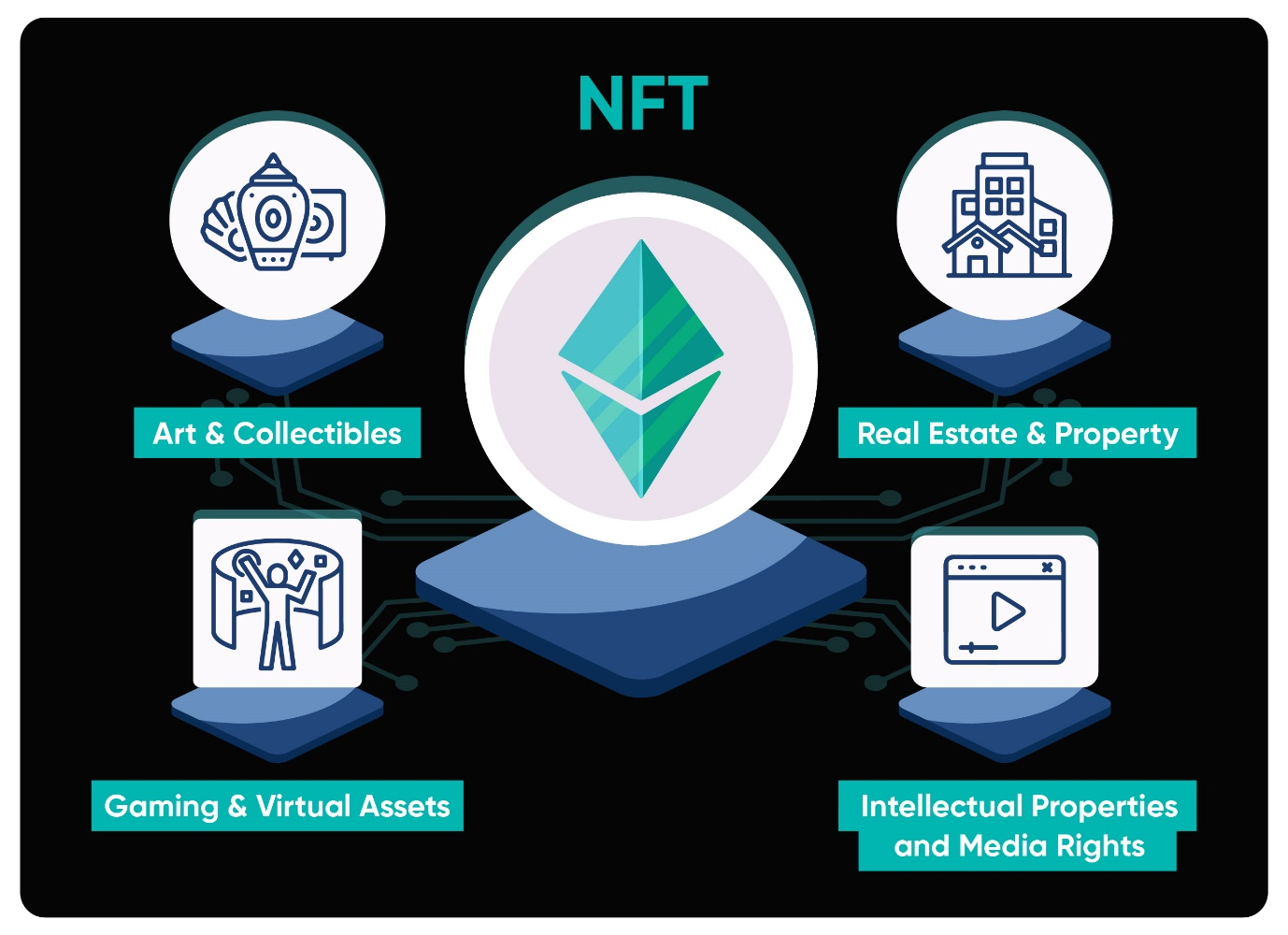
Art and Collectibles
The art world has become a breeding ground for innovation with the emergence of NFTs. Artists are now wielding this technology to redefine how they create, sell, and connect with audiences.
NFTs empower artists to:
Reach a global audience
One of the most significant applications of NFTs in art lies in the creation of vibrant digital art marketplaces. Platforms like OpenSea and Rarible have transformed the landscape, providing artists with a dedicated space to showcase their digital creations as NFTs. These platforms not only empower artists to exhibit their work but also connect them with a global network of collectors. This eliminates geographical barriers and democratizes access to art, allowing artists to reach a wider audience than ever before.
Sell and authenticate digital artwork
Furthermore, NFTs offer a solution to the long-standing challenge of verifying the authenticity of digital art. Traditionally, the lack of a secure and verifiable ownership record has cast doubt on the legitimacy of digital artworks. NFTs leverage blockchain technology to create a tamper-proof record of ownership history for each NFT. This not only assures collectors they are acquiring genuine pieces but also empowers artists to receive proper recognition for their work.
Explore new revenue streams
The benefits for artists extend beyond establishing authenticity and reach. NFTs unlock new avenues for generating revenue. Unlike traditional art sales, NFTs can be programmed with royalty structures. This means that whenever an NFT is resold in the future, the original artist automatically receives a percentage of the sale price. This empowers artists to gain a sustainable income stream from their creations, even after the initial sale.
Enjoy fractional ownership
Beyond digital art, NFTs are making inroads into the realm of physical assets. This technology allows for the tokenization of physical artworks, sculptures, or even real estate. Essentially, an NFT can act as a digital certificate of ownership for a valuable physical asset.
This opens doors for fractional ownership, where multiple individuals can co-own a high-value asset by purchasing fractions of its corresponding NFT. This not only increases accessibility for investors but also streamlines the trading process for these assets by leveraging the secure and transparent nature of blockchain technology.
Gaming and Virtual Assets
The gaming industry has embraced NFTs to create new experiences and economic models. Here’s how NFTs are transforming gaming:
In-game assets and ownership
For years, gamers have poured countless hours into acquiring rare weapons, unique characters, and coveted items within their favorite games. However, the ownership of these in-game assets traditionally resided with the game developer, leaving players with little control over their virtual possessions. NFTs are revolutionizing this dynamic by empowering players with true ownership of their digital assets.
When an in-game item or character is represented by an NFT, players gain the freedom to buy, sell, or trade them on external marketplaces independent of the game itself. This fosters the creation of thriving virtual economies within games, allowing players to potentially earn a return on their investment in time and effort. Imagine selling that rare sword you spent months grinding for or trading your uniquely styled avatar with another player – NFTs make this a reality, blurring the lines between play and potential profit.
Play-to-earn models
NFTs are not just about ownership; they’re also transforming how players interact with and earn rewards within games. The concept of "play-to-earn" is rapidly gaining traction, where games leverage NFTs to incentivize players and create new avenues for monetization. Here’s how it works: by actively participating in the game world, players can earn NFTs or cryptocurrency as rewards.
These earned NFTs could represent anything from powerful in-game items to unique cosmetic upgrades for characters. The beauty lies in the ownership aspect – players can choose to hold onto these earned NFTs and utilize them within the game, or they can sell them on external marketplaces to other players for potential profit. This "play-to-earn" model injects a new layer of engagement, where dedication and skill can translate into real-world value.
Real Estate and Property
The potential applications of NFTs in real estate are still under exploration, but they offer exciting possibilities:
Fractional ownership and investment
Traditionally, real estate investment has often been out of reach for many due to the high capital required. NFTs offer a revolutionary solution through fractional ownership. By tokenizing real estate assets using NFTs, a single property can be divided into smaller, more manageable digital units.
This allows a wider range of investors to participate in the real estate market, purchasing a fraction of an NFT that represents ownership of a property. This increased accessibility can breathe new life into the market, fostering greater liquidity and opening doors for a more diverse group of investors to participate in the previously limited world of real estate ownership.
Tokenization of real-world assets
Just like unique paintings or collectible items, real estate can also be tokenized using NFTs. This essentially involves creating a digital certificate of ownership for a physical property on a blockchain ledger. This tokenization process paves the way for efficient trading of real estate assets on a digital platform.
Imagine a streamlined system where buying and selling properties involves secure digital transactions using NFTs, eliminating the need for lengthy paperwork and potentially expediting the overall process. Furthermore, NFT-based ownership records offer enhanced transparency and immutability, providing a secure and verifiable way to track ownership history and streamline property management. While regulatory frameworks are still evolving, the potential of tokenized real estate through NFTs is undeniable, offering a glimpse into a future where real estate transactions are smoother, more efficient, and accessible to a broader range of participants.
Intellectual Property and Media Rights
NFTs have the potential to revolutionize how intellectual property (IP) and media rights are managed in the digital age:
NFTs in Music, Film, and Literature
For creators in the music, film, and literature industries, NFTs offer a powerful tool to represent ownership of their digital creations. Imagine a musician tokenizing a limited edition of a new song, or a filmmaker creating NFTs for exclusive behind-the-scenes content. This empowers creators to not only sell these unique digital assets but also potentially establish new revenue streams. Imagine co-owning the rights to a famous song or movie script through fractionalized ownership via NFTs. This allows fans and investors to participate in the ownership of valuable IP assets, potentially sharing in future profits generated from licensing or merchandising deals.
Additionally, NFTs can be programmed with royalty structures, ensuring creators receive a percentage every time their NFT is resold in the future. This offers a significant advantage over traditional models where tracking and enforcing royalties can be a challenge. But that’s not all. Musicians can release exclusive NFT collections offering access to unreleased tracks, VIP experiences, or even voting rights on future creative decisions. Similarly, filmmakers can create NFT-gated communities for fans, providing them with exclusive content, merchandise, and behind-the-scenes insights. This fosters a more interactive and engaging experience for fans, strengthening the bond between creators and their communities.
Sports Memorabilia and Fan Engagement
The world of sports is also embracing NFTs. Imagine owning a unique digital collectible commemorating a legendary athlete’s career highlight or a limited-edition NFT ticket stub for a historic game. NFTs can represent ownership of digital sports memorabilia, offering fans a new way to connect with their favorite teams and athletes. Additionally, NFTs can be used to create exclusive fan clubs or access for NFT holders, fostering a more interactive and engaging sports viewing experience.
Digital Avatars and Identity in the Metaverse
With the rise of the metaverse, virtual spaces where users can interact and socialize, NFTs play a crucial role in establishing digital identity. Imagine a unique NFT avatar that represents you across different metaverse platforms. This avatar can be customized with NFT-based clothing, accessories, or even virtual real estate. NFTs empower users to own and personalize their digital identities within the metaverse, creating a more immersive and interconnected online experience.
Pros and Cons of Investing in NFTs
Investing in Non-Fungible Tokens (NFTs) presents both enticing opportunities and potential pitfalls. On the positive side, NFT investments offer the promise of substantial returns, with some digital assets fetching millions of dollars in auctions. This potential for high profitability attracts investors keen on identifying lucrative projects early on. Moreover, NFTs provide an avenue for portfolio diversification beyond traditional asset classes like stocks and bonds. Diversifying into NFTs can spread risk and potentially enhance overall portfolio performance.
One of the most appealing aspects of investing in NFTs is the sense of ownership and control they confer upon investors. Owning an NFT typically grants full control and ownership rights over the digital asset, which can be particularly appealing to collectors and investors valuing exclusive ownership of unique digital content. Furthermore, beyond financial gains, investing in NFTs can hold cultural and social significance. Supporting artists, creators, and communities within the digital art and gaming space can feel rewarding and align with personal values.
However, NFT investments come with their fair share of drawbacks. The market’s high volatility and susceptibility to speculation can lead to dramatic price fluctuations and significant financial losses if investments are not carefully considered and monitored. Additionally, the lack of comprehensive regulation in the NFT market exposes investors to risks such as fraud, scams, and legal disputes. The absence of regulatory oversight also contributes to uncertainties surrounding taxation and compliance.
Moreover, the environmental impact of NFTs has raised concerns regarding their sustainability. The process of minting and trading NFTs often involves substantial energy consumption, particularly on blockchain networks with high energy requirements like Ethereum. This environmental consideration has prompted discussions about the ecological footprint of NFTs and their contribution to climate change (more on this in the next section). Furthermore, the rapid proliferation of NFT projects has led to concerns about market saturation and the formation of speculative bubbles. Investing during a bubble could result in inflated prices that are not sustainable in the long term, leading to potential losses for investors.
Keep reading the next section, where we will take a deeper look into the legal and regulatory considerations surrounding NFTs!
Legal and Regulatory Considerations
The meteoric rise of NFTs has ushered in a wave of excitement and innovation. However, this nascent technology also presents a complex legal and regulatory landscape that demands careful consideration. This section explores some key challenges and areas of uncertainty surrounding NFTs, highlighting the need for a balanced approach that fosters innovation while protecting consumers and creators.
Intellectual Property Rights and Copyright Law
One of the core questions surrounding NFTs concerns the ownership rights associated with them. While purchasing an NFT grants you ownership of the digital asset itself, it doesn’t necessarily transfer the underlying copyright. Copyright ownership remains with the original creator unless explicitly transferred through a separate licensing agreement. This distinction is crucial, as copyright ownership grants creators a wider range of rights, including the ability to reproduce, distribute, and adapt the work.
The potential for derivative works and copyright infringement further complicates the picture. NFTs can be created using copyrighted material, raising concerns about unauthorized use. Clear legal frameworks are needed to establish a distinction between permissible artistic expression inspired by existing works and blatant infringement. Additionally, the application of moral rights, which grant creators control over how their work is presented and exploited, needs clarification in the context of NFTs.
Furthermore, artist resale rights, which entitle creators to a percentage of resale profits on the secondary market, might require adjustments. Traditionally, these rights apply to physical artworks. In the NFT world, where resales can happen rapidly and across different platforms, establishing a fair and transparent system for ensuring artists receive their rightful share of resale profits remains an ongoing challenge.
Securities Regulations and Compliance
Certain types of NFTs, particularly those representing fractional ownership of an asset or promising future returns, could be classified as securities by regulatory bodies. This classification would subject them to stricter regulations aimed at protecting investors. These regulations typically involve mandatory disclosures, investor suitability checks, and adherence to anti-fraud measures.
For example, if an NFT represents a share in a digital real estate project promising rental income, it might be deemed a security. This would trigger the need for detailed investor prospectuses outlining the risks and potential returns associated with the investment. Similarly, NFTs associated with play-to-earn models, where players earn in-game assets with potential real-world value, might also fall under securities regulations depending on their design and structure.
The evolving nature of the NFT market and the potential for innovation necessitate a flexible yet robust regulatory framework. Regulatory bodies need to strike a balance between safeguarding investors and fostering innovation within the NFT space.
Anti-Money Laundering (AML) and Know Your Customer (KYC) Regulations
The anonymity associated with certain blockchain technologies can pose a risk for money laundering and other illegal activities. The NFT market is also susceptible to scams and fraudulent activity, such as fake NFTs or rug-pull schemes where developers abandon a project after raising funds.
To mitigate these risks, NFT platforms need to comply with Anti-Money Laundering (AML) and Know Your Customer (KYC) regulations. This involves verifying user identities, monitoring transactions for suspicious behavior, and reporting any potential red flags to the authorities.
Implementing robust AML/KYC procedures is crucial for ensuring the legitimacy of NFT transactions and protecting the integrity of the market. This can also help prevent fraudulent activities such as "rug pulls," where developers abandon a project after raising funds through NFT sales.
While AML/KYC processes can add a layer of friction to user experience, they are essential for building trust and ensuring a healthy and secure NFT ecosystem.
Taxation of NFT Transactions
The tax treatment of NFT transactions remains a gray area in many jurisdictions. Creators may be taxed on the sale of their NFTs as income, while collectors could face capital gains tax on resales. The specific tax implications can vary depending on factors like the nature of the NFT, the purpose of the transaction, and the location of the parties involved.
Clear guidance from tax authorities is essential for both creators and collectors to navigate the complexities of NFT taxation. Without clear regulations, uncertainty can discourage participation and hinder the growth of the NFT market.
International Perspectives and Regulatory Challenges
The regulatory landscape for NFTs is still evolving and varies significantly across different countries. This lack of uniformity presents challenges for international NFT transactions and businesses. For instance, what constitutes security in one jurisdiction might not be classified as such in another. This discrepancy can create confusion and difficulty for businesses operating across borders.
Collaboration between regulatory bodies worldwide is crucial to developing a comprehensive and consistent regulatory framework for NFTs. This framework should strike a balance between fostering innovation, protecting consumers and investors, and preventing illegal activities.
By working together, governments and industry leaders can create a global environment that fosters the responsible and sustainable growth of the NFT market, ensuring its long-term success and positive impact on creators, collectors, and the broader digital economy.
Challenges and Limitations
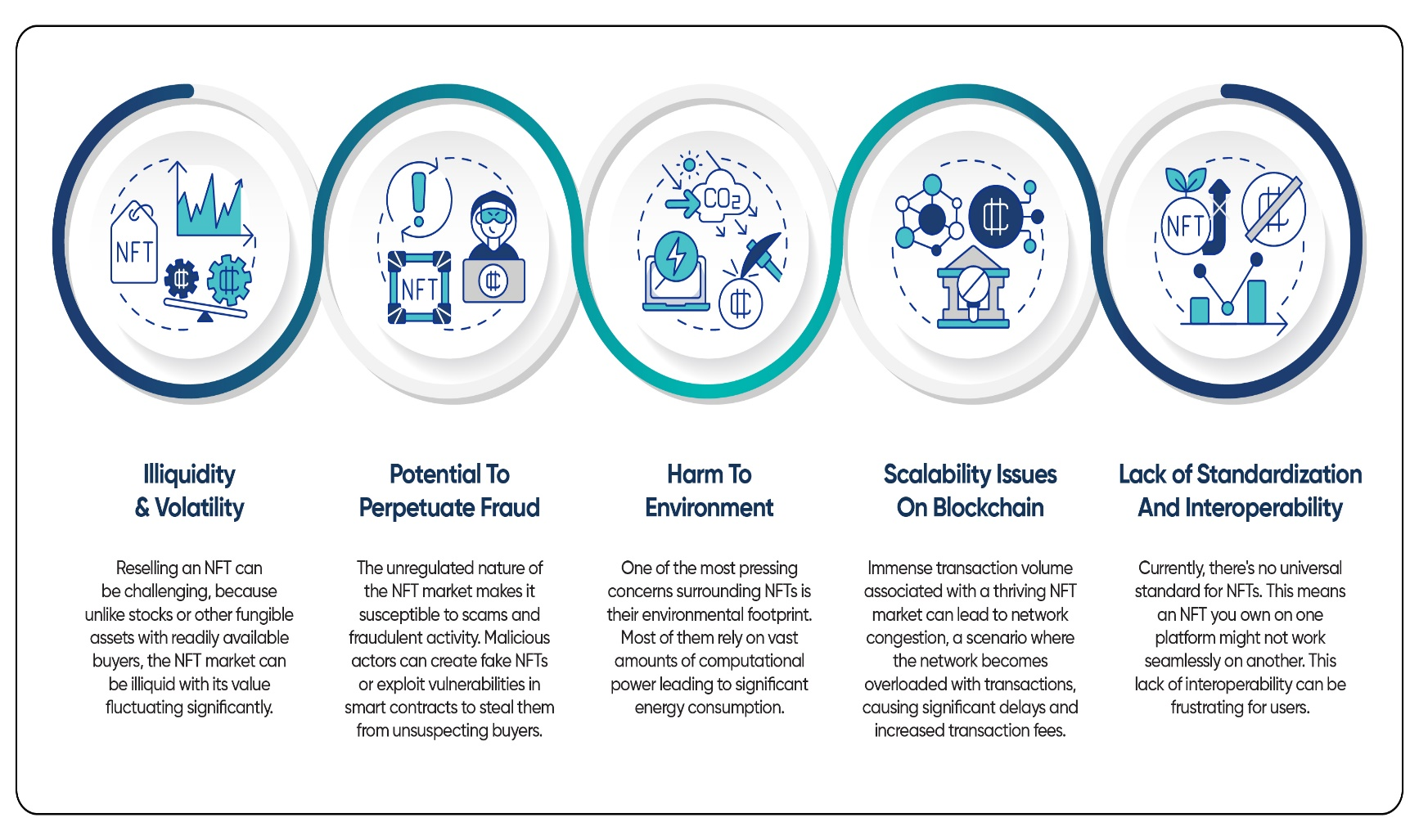
NFTs present exciting possibilities, but also face challenges and limitations that need to be addressed:
Environmental Impact of NFTs
One of the most pressing concerns surrounding NFTs is their environmental footprint. The "proof-of-work" consensus mechanism used by some popular blockchains, like Ethereum (a common platform for NFTs), relies on vast amounts of computational power. This translates to significant energy consumption, raising concerns about the environmental impact of NFTs. The energy used to power these computations can be substantial, and with the growing popularity of NFTs, the environmental cost becomes a significant factor to consider.
The good news is that the blockchain community is actively developing more sustainable solutions. "Proof-of-stake" is a promising alternative consensus mechanism that consumes significantly less energy compared to proof-of-work. Additionally, some NFT platforms are exploring the use of carbon offset programs to mitigate the environmental impact of their operations.
Moving forward, the development and adoption of energy-efficient blockchain solutions are crucial for ensuring the long-term sustainability of the NFT ecosystem. Creators, collectors, and developers alike have a responsibility to embrace innovation that minimizes the environmental impact of this exciting technology.
Scalability Issues on Blockchain Networks
The ever-growing popularity of NFTs has exposed limitations in the underlying blockchain technology. Popular blockchains, like Ethereum, were not initially designed to handle the immense transaction volume associated with a thriving NFT market. This can lead to network congestion, a scenario where the network becomes overloaded with transactions, causing significant delays and increased transaction fees.
Imagine waiting hours for a simple NFT transaction to be confirmed, all while being charged exorbitant fees – this can be a frustrating experience for both creators and collectors.
These scalability issues pose a significant challenge to the widespread adoption of NFTs. Thankfully, developers are actively working on scaling solutions for blockchains. These solutions aim to increase the number of transactions a network can process per second, ultimately reducing congestion and transaction fees.
Examples include Layer 2 scaling solutions that operate alongside the main blockchain or sharding, which essentially divides the blockchain into smaller, more manageable partitions. The successful implementation of these scaling solutions will be crucial for ensuring the NFT market can function smoothly and efficiently as it continues to grow.
Market Volatility and Speculation
The NFT market, while brimming with potential, is undeniably young and susceptible to fluctuations. This volatility can be attributed to several factors, including the inherent novelty of the technology, the subjective nature of value in the digital art world, and the potential for hype and social media trends to influence buying decisions.
This creates an environment ripe for speculative behavior, where some participants might prioritize short-term gains over intrinsic value. The risk? Inflated prices could come crashing down, potentially leading to significant financial losses for investors.
Before entering the NFT marketplace, it’s crucial for potential buyers to approach the process with a healthy dose of caution. Conduct thorough research on the NFT project, the team behind it, and the overall market trends. Remember, NFTs are not guaranteed investments, and just like any emerging technology, there’s an inherent risk involved. Responsible participation, driven by a genuine interest in the underlying asset rather than pure speculation, is key to navigating the exciting yet unpredictable world of NFT ownership.
Lack of Standardization and Interoperability
Currently, NFTs are often restricted to the platform they were created on, limiting their use and value. For example, currently, the excitement of acquiring a rare NFT weapon in your favorite game can be dampened by the realization that it’s only usable within that specific game world. This limitation restricts the overall value and utility of these in-game NFTs.
However, the future holds immense promise for interoperable NFTs. Imagine using your prized NFT sword not only in your favorite game but also across various other gaming platforms. This interoperability would create a more unified and valuable virtual asset ecosystem, allowing players to truly own and utilize their digital treasures across a wider range of gaming experiences.
While technical challenges remain, the potential for interoperable NFTs is undeniable, paving the way for a more connected and immersive gaming landscape. Industry-wide efforts to standardize NFT protocols and formats are essential to enable interoperability between different platforms and create a more unified NFT ecosystem.
Security Risks and Vulnerabilities
The exciting world of NFTs also comes with inherent security risks. Smart contracts, the self-executing code that governs NFT ownership and transactions, can harbor vulnerabilities that malicious actors can exploit. These vulnerabilities could allow hackers to steal NFTs directly from wallets or manipulate transactions for their own gain. The decentralized nature of blockchain technology, while offering transparency and immutability, also means that mistakes or exploits within a smart contract can be irreversible.
To combat these risks, NFT platforms need to implement robust security measures, including regular audits of smart contracts to identify and patch potential vulnerabilities. Additionally, user education is paramount.
Understanding best practices for secure storage of NFT credentials and remaining vigilant against phishing scams and other social engineering attacks are crucial steps for NFT users to protect their valuable digital assets.
Future Trends and Outlook

The future of NFTs holds immense potential for innovation and disruption across various sectors. Here, we explore some key trends shaping the future landscape:
Evolution of NFT Marketplaces and Platforms
NFT platforms will become more user-friendly and accessible, attracting a wider audience and mainstream adoption.NFT platforms will offer advanced features like fractional ownership, lending protocols, and integration with DeFi (Decentralized Finance) applications. Platforms will prioritize showcasing high-quality NFT projects and facilitating easier discovery for collectors and investors.
Integration of NFTs with Web 3.0 Technologies
NFTs will play a crucial role in building virtual worlds and economies within the metaverse. They can represent ownership of virtual land, avatars, and other digital assets.NFTs could be used to create secure and portable digital identities usable across different platforms and applications in the Web 3.0 space. Advancements in blockchain technology will enable greater interoperability between NFT platforms and applications, allowing for more seamless use of NFTs across different Web 3.0 ecosystems.
Institutional Adoption and Mainstream Acceptance
As the NFT market matures, we can expect established brands and institutions to explore the potential of NFTs for marketing, customer engagement, and loyalty programs. Similarly, clearer regulatory frameworks will create a more stable environment for institutional investment and broader adoption of NFTs.The widespread adoption of NFTs could disrupt and redefine traditional industries like art, music, gaming, and collectibles.
Potential for NFTs in Decentralized Finance (DeFi)
DeFi applications utilizing NFTs as collateral for loans can unlock new avenues for borrowing and lending in the crypto space.NFTs can also represent fractional ownership of DeFi assets like liquidity pools, making them more accessible to a broader investor base.NFTs can pave the way for the creation of innovative tokenized assets and financial instruments within the DeFi ecosystem.
Social and Cultural Implications of NFT Adoption
NFTs challenge traditional notions of ownership and value in the digital world. This raises questions about the future of digital ownership and its impact on our relationship with virtual assets.NFTs can foster the creation of strong online communities centered on shared interests in specific NFT projects or content creators.NFTs also empower creators to directly connect with fans and monetize their work without intermediaries. This holds the potential to democratize the creative economy and support independent artists.
Conclusion
Non-fungible tokens (NFTs) have stormed onto the scene, disrupting industries and igniting a global conversation about digital ownership and value. This paper has explored the essence of NFTs, their transformative potential across various creative fields, and the technical underpinnings that power this innovative technology.
However, the NFT landscape is not without its challenges. Legal and regulatory frameworks are still evolving, and environmental concerns surrounding energy consumption require sustainable solutions. Additionally, the market’s volatility and security risks necessitate responsible participation and robust security measures.
Despite these challenges, the future of NFTs is brimming with possibilities. From revolutionizing intellectual property management to fostering new avenues for creator monetization and community engagement, NFTs hold the power to reshape our digital interactions. As the technology matures, and regulations adapt, NFTs have the potential to become a powerful tool for creators, collectors, and innovators alike, ushering in a new era of ownership and value in the digital world.



